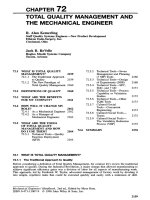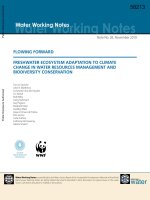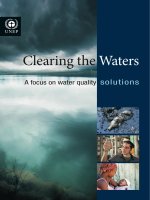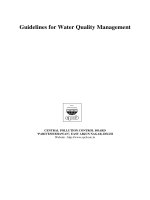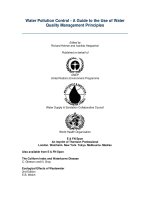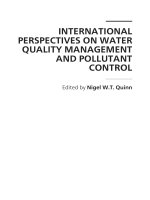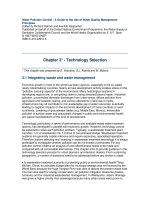INTERNATIONAL PERSPECTIVES ON WATER QUALITY MANAGEMENT AND POLLUTANT CONTROL doc
Bạn đang xem bản rút gọn của tài liệu. Xem và tải ngay bản đầy đủ của tài liệu tại đây (4.34 MB, 130 trang )
INTERNATIONAL
PERSPECTIVES ON WATER
QUALITY MANAGEMENT
AND POLLUTANT
CONTROL
Edited by Nigel W.T. Quinn
International Perspectives on Water Quality Management and Pollutant Control
/>Edited by Nigel W.T. Quinn
Contributors
Abdurahman H Nour, Huynh Viet Khai, Tin-Chun Chu, Matthew Rienzo, Juana Cortes, Cesar Calderon, Alejandra
Martin, Gabriela Moeller
Published by InTech
Janeza Trdine 9, 51000 Rijeka, Croatia
Copyright © 2013 InTech
All chapters are Open Access distributed under the Creative Commons Attribution 3.0 license, which allows users to
download, copy and build upon published articles even for commercial purposes, as long as the author and publisher
are properly credited, which ensures maximum dissemination and a wider impact of our publications. After this work
has been published by InTech, authors have the right to republish it, in whole or part, in any publication of which they
are the author, and to make other personal use of the work. Any republication, referencing or personal use of the
work must explicitly identify the original source.
Notice
Statements and opinions expressed in the chapters are these of the individual contributors and not necessarily those
of the editors or publisher. No responsibility is accepted for the accuracy of information contained in the published
chapters. The publisher assumes no responsibility for any damage or injury to persons or property arising out of the
use of any materials, instructions, methods or ideas contained in the book.
Publishing Process Manager Sandra Bakic
Technical Editor InTech DTP team
Cover InTech Design team
First published February, 2013
Printed in Croatia
A free online edition of this book is available at www.intechopen.com
Additional hard copies can be obtained from
International Perspectives on Water Quality Management and Pollutant Control, Edited by Nigel W.T.
Quinn
p. cm.
ISBN 978-953-51-0999-0
free online editions of InTech
Books and Journals can be found at
www.intechopen.com
Contents
Preface VII
Chapter 1 Bloom-Forming Cyanobacteria and Other Phytoplankton in
Northern New Jersey Freshwater Bodies 1
Tin-Chun Chu and Matthew J. Rienzo
Chapter 2 Endocrine Disruptors in Water Sources: Human Health Risks
and EDs Removal from Water Through Nanofiltration 25
J. E. Cortés Muñoz, C. G. Calderón Mólgora, A. Martín Domínguez,
E. E. Espino de la O, S. L. Gelover Santiago, C. L. Hernández Martínez
and G. E. Moeller Chávez
Chapter 3 Impact of Industrial Water Pollution on Rice Production
in Vietnam 61
Huynh Viet Khai and Mitsuyasu Yabe
Chapter 4 The Performance Evaluation of Anaerobic Methods for Palm Oil
Mill Effluent (POME) Treatment: A Review 87
N.H. Abdurahman, Y.M. Rosli and N.H. Azhari
Chapter 5 Ultrasonic Membrane Anaerobic System (UMAS) for Palm Oil
Mill Effluent (POME) Treatment 107
N.H. Abdurahman, N.H. Azhari and Y.M. Rosli
Preface
The level of surface water quality protection is variable around the world in large part due to the
relative effectiveness of environmental regulation and the degree to which science influences
the regulatory process. In the United States, at the federal level, the Total Maximum Daily Load
(TMDL) has been an effective policy and water quality management tool for dealing with both
point source and non-point source pollution. The TMDL provides a rational framework for esti‐
mating the assimilative capacity of the receiving water body for certain contaminants and ap‐
plying factors of safety and incorporating acceptable levels of water quality criteria violation -
provided the local stakeholders have a say in the decision making process.
This collection of articles from around the world are good examples of the application of sound
scientific principles to solve pressing water quality problems. Tin-Chun Chu and Matthew Rien‐
zo describe techniques for the detection and identification of bloom-forming phytoplankton in
freshwater lakes and streams in the state of New Jersey, USA. They developed a protocol using
microscopic observation, PCR assay analysis and flow cytometry that allowed rapid identifica‐
tion of cyanobacteria species causing algal blooms. The second paper by Juana Cortes, Gabriela
Moeller, Alejandra Martin and Cesar Calderon examines endocrine disruptors in water sources
and determines both human health risk and the efficacy of endocrine disruptor removal using
various water treatment alternatives in Valle del Mezquital, Mexico. Comparison of ultra-low
pressure reverse osmosis membranes (ULPRO) and nanofiltration (NF) showed that both types
of membrane could reach efficient levels of removal of organic compounds such as pharmaceut‐
icals, pesticides, flame retardants, plasticizers, and nitrogen, similar to that of conventional re‐
verse osmosis, producing water with equal quality as required for indirect potable reuse of
treated water. The third paper by Huynh Viet Khai and Mitsuyasu Yabe examined the impact of
industrial water pollution on rice production in Vietnam. The authors surveyed rice farmers in
two areas with similar environmental conditions and social characteristics differing mainly with
respect to industrial pollution. The authors describe a theoretical econometric analysis using
Cobb-Douglas cost functions to examine the causes of the reduction in rice production related to
water pollution based on estimated rice yield differences between the two regions. The last two
papers written by the same author Abdurahman Nour provide a literature review of ultrasoni‐
cated membrane anaerobic systems used to treat palm oil mill river effluent pollution problems.
This review is followed by a paper that reports on a ultrasonicated membrane anaerobic system
that has been successfully used to treat palm oil mill effluent.
Dr. Nigel W.T. Quinn
Group Leader,
Engineering Advanced Decision Support Research Group (HEADS),
The Earth Sciences Division, Berkeley National Laboratory, USA
Chapter 1
Bloom-Forming Cyanobacteria and Other
Phytoplankton in Northern New Jersey Freshwater
Bodies
Tin-Chun Chu and Matthew J. Rienzo
Additional information is available at the end of the chapter
/>1. Introduction
1.1. Phytoplankton
Phytoplankton not only plays a vast role in the aquatic food chain, but some groups are es‐
sential in the production of atmospheric oxygen [1]. Phytoplankton include cyanobacteria,
algae and many other groups. Some of the most common types of phytoplankton in North
American freshwater bodies include species of Bacillariophyceae (diatoms) as well as thou‐
sands of species of cyanobacteria.
Diatoms are a type of phytoplankton that possess several unique contours due to a cell wall
composed of silicon dioxide (SiO
2
) [2, 3]. The diatoms, or Bacillariophyta, have distinct
structures and thus are easily identifiable in a water sample. Diatoms can be found in a large
range of pH and dissolved oxygen values as well as in ecosystems with a wide concentra‐
tion of solutes, nutrients, contaminants, and across a large range of water temperatures due
to their durable cell walls [2].
There are many species of cyanobacteria, commonly found in freshwater lakes and ponds as
well as marine environments. Originally called blue-green algae because of their color, cya‐
nobacteria is a phylum of bacteria that uses photosynthesis to obtain energy. Cyanobacteria
are prokaryotes and possess the pigment chlorophyll a, which is necessary for oxygenic pho‐
tosynthesis and can be exploited during molecular analysis to detect the presence of cyano‐
bacteria in a sample [4]. Cyanobacteria aided in the transformation of the Earth’s
atmosphere by producing atmospheric oxygen [1]. Freshwater cyanobacteria can be found
as unicellular, filamentous, or colonial cells within the environment. Some of the common
© 2013 Chu and Rienzo; licensee InTech. This is an open access article distributed under the terms of the
Creative Commons Attribution License ( which permits
unrestricted use, distribution, and reproduction in any medium, provided the original work is properly cited.
cyanobacteria found in freshwater sources in North America include Synechococcus, Ana‐
baena, Oscillatoria, Nostoc, and Anacystis [2].
1.2. Algal blooms
Although the necessity for cyanobacteria and other phytoplankton in the environment is ap‐
parent, overgrowth in urbanized areas due to eutrophication results in formation of algal
blooms, causing deleterious effects to both aquatic life as well as anything that may come in
contact with the water. Some of the common algal bloom-forming cyanobacteria include
those with filamentous and colonial cells [5].
Eutrophic freshwater ecosystems may contain a high average algal biomass include phyto‐
planktons such as cyanobacteria, chlorococcales or dinoflagellates [1, 6]. Eutrophication is
the water body’s response to added nutrients like phosphate and nitrates. In urbanized
areas, the human factor of nutrient introduction to these ecosystems, otherwise known as
cultural eutrophication, has recently been considered as one of the most important factors
driving the increase in algal bloom frequency as well as intensity [7]. Fertilizer runoff, car
washing, and pet wastes being discarded into storm drains are three major modern events
causing changes that disturb existing equilibrium between phytoplankton and other aquatic
life, accelerating eutrophication [1]. The algal mat that forms at the water’s surface can easily
prevent sun from penetrating the lower portions of the water. In figure 1 below, an exten‐
sive algal bloom is seen in Branch Brook State Park Lake in Newark, NJ.
1.3. Cyanotoxin
Algal bloom production can be harmful due to decreased sunlight penetration, decreased
dissolved oxygen, and also possible toxin release by certain species of cyanobacteria [8].
Many species of cyanobacteria can produce toxins, posing a further risk for aquatic life.
There are about 50 species of cyanobacteria that have been shown to produce toxins which
are harmful to invertebrates. Microcystis, Anabaena, Oscillatoria, Aphanizomenon, and
Nodularia are a few genera which contain species known to produce cyanotoxins. There are
three main types of cyanotoxins. Neurotoxins affect the nervous system, hepatotoxins affect
the liver, and dermatoxins affect the skin (NALMS) [9]. It could pose a serious threat for
both human and animal health if they consume the water from the contaminated sites. Mi‐
crocystins and other cyanotoxins are heat stable, thus cannot be destroyed by boiling. Also,
many cyanotoxins are not easily separated from drinking water if they are dissolved in wa‐
ter. Currently, there are several cyanotoxins that are on the US EPA Contaminant Candidate
List (CCL2) which are being evaluated for human toxicity (NALMS) [10]. Exposure routes of
these cyanotoxins are dependent on the purpose of the contaminated water. If the contami‐
nated water is part of a reservoir, the exposure route may be ingestion due to improperly
filtered drinking water. If the contaminated water is used for recreational use, the exposure
route may be skin, ingestion, or inhalation. Human exposure may also come from ingestion
of animals that were living in the contaminated water. Saxitoxins, known neurotoxins se‐
creted by several cyanobacterial species including Anabaena circinalis, are also known as pa‐
ralytic shellfish toxins (PSTs). These neurotoxins infect shellfish, which in turn infect
International Perspectives on Water Quality Management and Pollutant Control2
humans who ingest those shellfish [11]. This neurotoxin, along with the other cyanotoxins
produced by cyanobacteria, currently has no antidote [12].
1.4. Detection and treatment of algal blooms
The need for treatment of contaminated freshwater across the world is at an all-time high
due to the increase in urbanization. In order to prevent harmful algal blooms from forming,
it is necessary to understand the balance between cyanobacteria and their viruses, cyano‐
phage. Cyanophage are viruses that infect cyanobacteria in a species specific manner and
are just as ubiquitous as cyanobacteria in ecosystems [13]. So, the first step in possibly de‐
tecting and preventing algal bloom formation is to identify the common species at each sus‐
ceptible freshwater body. Microscopy can be used to identify organisms found within
environmental samples. Microscopy allows for identification as well as determination of cell
density within the sample. Microscopy, unfortunately, is inefficient and time consuming. As
a complement to microscopy, polymerase chain reaction (PCR) can be employed. PCR can
be used to prime for conserved regions among all phyla of cyanobacteria and other phyto‐
plankton. In an environmental sample, it is important to first perform PCR using universal
cyanobacterial primers in order to determine the presence of cyanobacteria. There have been
previous studies in which both universal and phyto-specific primers have been determined
to be effective in amplifying the 16s rRNA genes in cyanobacteria [14, 15]. After cyanobacte‐
rial presence has been confirmed, species specific primers are then used to effectively deter‐
mine the profile of the freshwater ecosystem being tested. Using the combined microscopic
analysis with molecular techniques allows for an effective and efficient method in determin‐
ing cyanobacterial profiles among freshwater ecosystems. Flow cytometry is another meth‐
od that could be used as a complement to microscopy and PCR. Flow cytometry can exploit
the fact that phytoplankton contain chlorophyll a. A flow cytometer uses a laser and can per‐
form cell differentiation and quantification based on physical characteristics of cells [16].
With the use of these three methods, a successful profile can be generated observing com‐
mon species at particular water bodies.
1.5. Water chemistry and lake turnover
pH is a water chemistry parameter that is influenced as much by the external environment
than it is internal environment of the water body. The pH of water is partially affected by
the CO
2
system components (CO
2
, H
2
CO
3
, and CO
3
2-
). Under basic conditions (pH>7.0), the
CO
2
concentration is related to photosynthesis [17]. Since most algal cells (cyanobacteria or
phytoplankton) take in CO
2
during their growth process, the pH of the water body falls
within a favorable range for growth of a particular genus or species. Some species, at condi‐
tions in which the pH is more than 8.6, may be limited in CO
2
uptake due to inactive ion
transport mechanisms. But, it is also known that photosynthesis can occur at a pH of 9-10 in
some species. Reduction of photosynthesis is noted at pH above 10 in all species [1].
Dissolved oxygen is another water chemistry parameter that is affected by both internal and
external environments. As algal blooms grow, eventually they will exhaust all essential nu‐
trients available in the water body. When this occurs, there is a decrease in biomass pres‐
Bloom-Forming Cyanobacteria and Other Phytoplankton in Northern New Jersey Freshwater Bodies
/>3
ence, which eventually leads to decaying of the algal bloom, producing a scum that
decreases the underlying water‘s oxygen. This depletion of dissolved oxygen can lead to
several changes that include hypoxia, in which the dissolved oxygen concentration has
dropped below 4 mg/L, or anoxia, in which there is no detectable oxygen levels in the water,
leading to death among most finfish and shell fish [18].
Seasonal pond or lake turnover could have had a profound effect on the abundance and
population shift of phytoplankton when comparing the summer and fall collections. Lake
turnover is a natural event that results in the mixing of pond and lake waters, caused by the
changing temperatures in surface waters during the shifting of seasons [19, 20]. The density
and weight of water change when temperature changes in the freshwater lakes. Water is
most dense at 4°C; it becomes less dense when the temperature drops below 4°C, thus rising
to the top [20]. This is how fish and other aquatic life can survive during the winter at the
floor of the water body, with the warmer water surrounding them towards the sediment
[19]. This feature, along with the fact that colder water having a higher capacity for dis‐
solved oxygen, can support the fact that phytoplankton numbers are significantly reduced
during the colder months. Pond or lake turnover could affect the phytoplankton survival by
keeping the colder water at the surface of the water body, where phytoplanktons need to
remain for sunlight and photosynthesis. Because colder surface temperatures do not support
phytoplankton growth, the phytoplankton cell numbers and algal blooms should be greatly
reduced after the fall turnover occurs, and may return after the spring turnover is complete.
1.6. Algal biomass dynamics in Northern New Jersey freshwater bodies
The New Jersey Department of Environmental Protection (NJDEP) has developed the
NJDEP Ambient Lake Monitoring Network, in which lakes and ponds around the state of
New Jersey are tested for water quality. The Network tests at least one station and one out‐
let of each water body. At these stations, the NJDEP tests for total depth, profile depth, Sec‐
chi, water temperature, dissolved oxygen, pH, conductivity, phosphorous, nitrates,
chlorophyll a, and turbidity, among other water quality factors.
Essex County, New Jersey, is one of the most densely populated counties in the state of New
Jersey, consisting of a population of 783,969 in a land area of 127 square miles [21, 22]. Essex
County is a heavily urbanized county located in the New York Metropolitan area. Essex
County contains 12 major highways, three of the nation’s major transportation centers
(Newark Liberty International Airport, Port Newark, Penn Station), and 1,673 miles of pub‐
lic roads [21]. These factors, combined with the massive industrial centers producing goods
ranging from chemicals to pharmaceuticals, contribute to the urbanization of the area. De‐
spite being heavily urbanized, Essex County has several parks, freshwater rivers, lakes, and
ponds which contribute to the continued efforts in beautification and habitat diversity of the
region. These bodies of water, being continually subjected to harmful elements from man‐
made chemicals and excess nutrient pollution, have seen an increase in phytoplankton
blooms. Increases in the amounts of nutrients entering lakes and reservoirs in recent deca‐
des in urbanized settings as well as associated changes in the water body’s biologics have
contributed to the increase in focus on the problem of nutrient enrichment due to pollution,
International Perspectives on Water Quality Management and Pollutant Control4
called eutrophication [1, 22]. Eutrophication and harmful algal blooms are serious global en‐
vironmental issues.
In the present study, five lakes in Essex County, New Jersey were sampled in the summ‐
er and fall of 2011. Sites were tested for pH, dissolved oxygen, and temperature to ob‐
serve environmental conditions which harbor algal bloom formation. Samples were
subsequently tested for the presence of cyanobacteria and phytoplankton using the three
methods described above: Microscopic analysis, polymerase chain reaction, and flow cy‐
tometry. Microscopic analysis was performed to identify individual species of cyanobac‐
teria and other phytoplankton among each site at each of the five lakes tested. Once
cyanobacteria were confirmed and several species identified, polymerase chain reaction
was used with universal primers to confirm the presence of cyanobacteria as well as spe‐
cies specific primers to confirm the presence of particular species. Flow cytometry was
utilized to compare seasonal profiles as well as to compare the cyanobacterial cell con‐
centrations among the water samples.
2. Materials and methods
2.1. Cyanobacterial cultures
Synechococcus sp. IU 625 and Synechococcus elongatus PCC 7942 strains were used as controls
in this study. Five ml of cells were inoculated in 95 ml of sterilized Mauro’s Modified Medi‐
um (3M) [23] in 250 ml Erlenmeyer flasks [24]. The medium was adjusted to a pH of 7.9 us‐
ing 1 M NaOH or HCl. The cultures were grown under consistent fluorescent lighting and at
a temperature of 27° C. The cultures were grown on an Innova™ 2000 Platform Shaker
(New Brunswick Scientific, Enfield, CT, USA) with continuous pulsating at 100 rpm.
2.2. Environmental samples
Water samples were collected from several water bodies in Essex County, New Jersey in
2011. Permission was granted from the Essex County Department of Parks, Recreation
and Cultural Affairs for sample collections. There were two collection periods in this
study: May 2011-August 2011 (Summer Collections) and October 2011-November 2011
(Fall Collections) to observe microorganism profile seasonal differences. Three to five
samples were collected at each body of water, varying in location and water movement.
The five bodies of water observed in this study were Diamond Mill Pond (Millburn, NJ,
USA), South Orange Duck Pond (South Orange, NJ, USA), Clarks Pond (Bloomfield, NJ,
USA), Verona Lake (Verona, NJ, USA), and Branch Brook State Park (Newark, NJ, USA).
Before collection, each site was tested for pH, dissolved oxygen, and temperature using
the ExStickII
®
pH/Dissolved Oxygen (DO)/ Temperature meter (ExTech
®
Instruments
corp., Nashua, NH, USA). Samples were collected from each water body in 1 L sterile
collection bottles (Nalgene, Rochester, NY, USA). The one liter samples were brought to
the lab (Seton Hall University, South Orange, NJ, USA) to be further processed. Each
sample was run through a coarse filter with a pore size of 2.7 µm (Denville Scientific,
Bloom-Forming Cyanobacteria and Other Phytoplankton in Northern New Jersey Freshwater Bodies
/>5
Metuchen, NJ, USA). Filtrate from the coarse filtered sample was run through a fine fil‐
ter with a pore size of 0.45 µm (Nalgene, Rochester, NY, USA). Both coarse and fine fil‐
ter from each sample were placed in a Thelco™ Model 2 incubator for drying at 37°C
(Precision Scientific, Chennai, India). Aluminum foil was sterilized by UV light using a
Purifier Vertical Clean Bench (Labconco, Kansas City, MO, USA). Dried filters were
placed on sterilized aluminum foil and placed in -20°C freezer for further studies.
2.3. Genomic DNA extraction
Genomic DNA of S. IU 625 and S. elongatus PCC 7942 were extracted using Fermentas® Ge‐
nomic DNA Purification Kit (Fermentas, Glen Burnie, MD, USA). Ten ml of cyanobacteria
cells (OD750 nm = ~1) were placed in a 15 ml conical tube. The conical tubes were then cen‐
trifuged and cells were resuspended in 200 µl of TE Buffer. 200 µl of cells were then mixed
with 400 µl lysis solution in an Eppendorf tube (Enfield, CT, USA) and incubated in an Iso‐
temp125D™ Heat Block (Fisher Scientific, Pittsburgh, PA, USA) at 65°C for 5 minutes. 600 µl
of chloroform were added and emulsified by inversion. The sample was then centrifuged at
10,000 rpm for two minutes in a Denville 260D microcentrifuge (Denville Scientific, South
Plainfield, NJ, USA). While centrifuging, the precipitation solution was prepared by mixing
720 µl of deionized water with 80 µl of 10X concentrated precipitation solution. After centri‐
fugation, the upper aqueous phase was transferred to a new tube and 800 µl of the precipita‐
tion solution were added. The tube was mixed by several inversions at room temperature
for two minutes and centrifuged at 10,000 rpm for two minutes. The supernatant was re‐
moved completely and the DNA pellet was dissolved by adding 100 µl of 1.2 M NaCl solu‐
tion with gentle vortexing. 300 µl of cold ethanol (100%) was added to enable DNA
precipitation and kept in -20°C for 10 minutes. The tube was then centrifuged at 10,000 rpm
for three minutes. Ethanol was discarded and the pellet was washed with 70% cold ethanol.
The DNA was then dissolved in sterile deionized water, and the DNA concentration and
purity were determined with NanoDrop ND-1000 Spectrophotometer (Thermo Fisher Scien‐
tific, Wilmington, DE, USA).
2.4. Chelex® DNA extraction of environmental samples
All environmental samples underwent a modified Chelex
®
DNA extraction as follows. Each
filter (for both coarse and fine filters) was hole punched 3-4 times at various spots on the
filter to produce three to four disks; disks were placed into 1.5 ml Eppendorf tubes. Five
hundred microliters of deionized water were added to each tube and each tube was vor‐
texed. Tubes were let stand for 10-15 minutes. All tubes were centrifuged for three minutes
at 10,000 rpm to concentrate the pellet. Clear supernatant was discarded from each tube, and
200 µl of InstaGene Matrix (Bio-Rad Laboratories, Hercules, CA, USA) were added. Each
tube was vortexed for 10 seconds. The tubes were incubated for two hours in a Polyscience
©
Temperature Controller water bath (Polyscience, Niles, IL, USA) at 56° C, vortexed for 10
seconds, and placed in an Isotemp125D™ Heat Block (Fisher Scientific, Pittsburgh, PA,
USA) for 8 minutes at 100°C. The tubes were then centrifuged for 10 minutes at 10,000 rpm,
and the supernatant (containing DNA) was transferred to clean Eppendorf tubes. The DNA
International Perspectives on Water Quality Management and Pollutant Control6
concentration and purity were determined with NanoDrop ND-1000 Spectrophotometer
(Thermo Fisher Scientific, Wilmington, DE, USA).
2.5. Polymerase Chain Reaction (PCR)-based assays
DNA extracted from the environmental samples, along with the controls (S. IU 625, S.
elongatus PCC 7942) was amplified using general and specific primers to identify the
presence of bacteria, cyanobacteria, phytoplankton, and the dominating species. General
primers were used to identify bacteria, cyanobacteria, and phytoplankton by utilizing the
bacteria-specific 16s rRNA gene primers 27FB and 785R, PSf and PSr, and CPC1f and
CPC1r, respectively. Specific primers were used after phytoplankton and cyanobacteria
were detected in the samples. PCR was performed using 6.5 µl nuclease-free deionized
water (Promega, Madison, WI, USA), 2.5 µl dimethyl sulfoxide (DMSO), 1 µl of primer
in the forward orientation, 1 µl of primer in the reverse orientation, 1.5 µl of DNA sam‐
ple, and 12.5 µl GoTaq
®
Hot Start Green Master Mix (Promega). Thermocycling was per‐
formed in Veriti 96 Well Thermocycler (Applied Biosystems, Carlsbad, CA, USA). The
initial denaturation step was at 95°C for 2 minutes, followed by 35 cycles of DNA dena‐
turation at 95°C for 45 seconds, primer annealing at 50-55°C for 45 seconds, and DNA
strand extension at 72°C for 45 seconds, and a final extension step at 72°C for 5 minutes.
The amplified DNA was visualized on a 1% agarose gel with ethidium bromide incorpo‐
rated using TAE electrophoresis buffer (Fermentas). The gel was visualized using a 2UV
Transilluminator Gel Docit Imaging System (UVP, Upland, CA, USA).
Primers used in this study were either developed using NCBI BLAST (http://
www.ncbi.nlm.nih.gov/BLAST) or by previous studies in this subject field. The sequences
of the selected primers, their target organisms and the size of the amplicons are listed in
Table 1.
General primers included Phytoplankton-Specific PSf/PSr which identified the 16s rRNA
gene in all phytoplankton [17]. Universal primers Uf/Ur identified the 16s rRNA gene in all
bacteria [17]. General primers 27FB and 785R were utilized to identify the 16s rRNA in all
bacteria, cyanobacteria, and phytoplankton [21]. CPC1f/CPC1r are also cyanobacteria specif‐
ic primers which identify the β-Subunit of the phycocyanin gene conserved among all cya‐
nobacteria [15]. AN3801f/AN3801r are also cyanobacteria specific primers, identifying the
DNA polymerase III gene conserved in S. IU625 and S. elongatus PCC 7942. Once cyanobac‐
teria and phytoplankton were identified in a sample, specific primers were obtained and uti‐
lized. Primers specific for Anabaena circinalis toxin biosynthesis gene cluster were developed
using NCBI BLAST searches: ANAf and ANAr. Primers to locate Microcystis were devel‐
oped in accordance with Herry et al. Diatom presence was identified using primers devel‐
oped in accordance with Baldi et al. 528f with 650r identified the small subunit ribosomal
DNA gene conserved among all diatom species [23].
Bloom-Forming Cyanobacteria and Other Phytoplankton in Northern New Jersey Freshwater Bodies
/>7
2.6. Microscopic analyses
Microscopic images were acquired using a Carl Zeiss AxioLab.A1 phase contrast micro‐
scope coupled with a Carl Zeiss AxioCam MRc camera (Carl Zeiss Microimaging, Jena, Ger‐
many). Coarse filters (2.7 µm pores) were hole punched one time. The fragment was placed
into an Eppendorf tube and 100 µl of deionized water were added. The tubes were left at
room temperature for 10-20 minutes. 16 µl of the tube’s contents were pipetted onto a micro‐
scope slide and viewed at 400X power under the phase filter. Images of diatoms, phyto‐
plankton and cyanobacteria were compared to the atlas “Freshwater Algae of North
America: Ecology and Classification” [2]. Species of cyanobacteria, diatoms, and phyto‐
plankton were identified for use in specific PCR analysis and amplification.
2.7. Flow cytometry
Flow cytometry was performed on several sites collected from Branch Brook State Park
(Newark, NJ) in June 2011 as well as December 2011 by a Guava
®
EasyCyte
™
Plus Flow Cy‐
tometry System (Millipore, Billerica, MA, USA). Fluorescence resulting from the excitation
Primer Target Organism Sequence Amplicon (bp)
CPC1f
Cyanobacteria
GGCKGCYTGYYTRCGYGACATGGA
389
CPC1r AARCGNCCTTGVGWATCDGC
27fB
Bacteria/
Photosynthetic plankton
AGAGTTTGATCMTGGCTCAG
740
785r ACTACCRGGGTATCTAATCC
ANAf
Anabaena circinalis
GATCTAGCCTCACCTGTTGACTT
457
ANAr GGGATCCTTTTTGCTGCGCC
528f
Diatoms
GCGGTAATTCCAGCTCCAA
200
650r AACACTCTAATTTTTTCACAG
PSf
Phytoplankton
GGGATTAGATACCCCWGTAGTCCT
150
Ur ACGGYTACCTTGTTACGACTT
Uf
Phytoplankton
GAGAGTTTGATCCTGGTCAG
700
PSr CCCTAATCTATGGGGWCATCAGGA
AN380f
S. IU 625 & S. elongatus PCC
7942
CAAATCACTCAGTTTCTGG
180
AN380r CAGTAGCAGCTCAGGACTC
Table 1. Seven primer sets used for PCR-based assays.
International Perspectives on Water Quality Management and Pollutant Control8
with a 488 nm laser was collected using both green and red filters. A 575 nm filter was used
to locate carothenoid pigments, while a 675 nm filter was used to locate chlorophyll a pig‐
ments, each of which would be indicative of cyanobacterial presence in the water sample.
Blanks were created by using Phosphate Buffered Saline (PBS) and deionized water. Tubes
were prepared by hole punching both coarse and find filters and placing them in Eppendorf
tubes with 100 µl deionized water, as mentioned above. Cyanobacterial presence was stud‐
ied in the coarse filter from Branch Brook Park site C from July 2011 (Algal Bloom present),
Branch Brook Sites C & D (Raw, unfiltered samples), and both Branch Brook Sites C & D
Coarse and Fine filters. Flow Cytometry results were analyzed using FlowJo 7.6.5 Flow Cy‐
tometry Analysis Software (Tree Star, Inc., Ashland, OR, USA).
3. Results
3.1. Water chemistry
The pH, dissolved oxygen, and temperature were analyzed at all sites in this study. These
parameters aided in the development of a profile for each water body, highlighting which
environmental conditions allowed for cyanobacterial and other phytoplankton overgrowth.
In Table 1 below, the range of water chemistry levels determined at all sites from summer
and fall collection is displayed. The data indicated that the pH range is broader in the fall
than in the summer. Dissolved oxygen levels were similar in two seasons and the tempera‐
ture differences ranged between 6.7 and 20.9 °C.
Water Chemistry pH Dissolved Oxygen (mg/L) Temperature (°C)
Summer 7.27 – 8.30 1-10 23.5 – 30
Fall 6.60-9.25 2-11 9.1-16.8
Table 2. The range of water chemistry parameters for water samples taken at 20 sites during the summer and fall
collections is shown.
3.2. Polymerase Chain Reaction (PCR)-based assays
Polymerase chain reaction based assays were performed using DNA extracted from both the
coarse and fine filters at each site among all water bodies involved in this study collected in
both the summer and fall to identify the presence of bacteria, cyanobacteria, and phyto‐
plankton within each body of water.
PCR-based assays were performed on the coarse and fine filters from each site collected
from each water body during the summer and the fall collections. Primer sets used for
these PCR-based assays include CPC1f/CPC1r and 27fB/785r for general identification of
cyanobacteria and photosynthetic bacteria, respectively. Synechococcus sp. IU 625 and Syn‐
echococcus elongatus PCC 7942, both lab strains, were used as positive controls in this
Bloom-Forming Cyanobacteria and Other Phytoplankton in Northern New Jersey Freshwater Bodies
/>9
study. In figures 1-3 below, selected gel electrophoresis results from these PCR-based as‐
says are displayed.
Figure 1. Results from Branch Brook State Park coarse and fine filters are shown using the CPC1f/CPC1r primer set to
detect cyanobacteria. It indicates that the presence of cyanobacteria in all 4 sites (A, B, C & D) of Brank Brook State
Park.
Figure 2. Results from Clarks, Verona and South Orange Duck Pond coarse and fine filters are shown using the 528f/
650r primer set to detect diatoms. It indicates that the presence of diatoms in all 4 sites (A, B, C & D) of Clarks Pond
and 2 sites of South Orange Duck Pond.
Figure 3. Results from Diamond Mill and Clarks Pond are shown using the 27fB/785r primer set to detect bacteria and
photosynthetic phytoplankton. This is indicative of bacterial and photosynthetic phytoplankton presence among all
sites tested.
International Perspectives on Water Quality Management and Pollutant Control10
Water bodies Sites collected Summer positive detection Fall positive detection
Brank Brook State Park A, B, C, D A, B, C, D A, B, C, D
Clarks Pond A, B, C, D, E A, B, C, D ND*
Diamond Mill Pond A, B, C, D A, C ND*
South Orange Duck Pond A, B, C, D A, B ND*
Verona Lake A, B, C A A
Table 3. Summary of cyanobacterial detection in the summer and in the fall among 5 water bodies. ND indicates non-
detectable. The results showed the fall water samples contain fewer cyanobacteria.
Water bodies Sites collected Summer positive detection Fall positive detection
Branch Brook State Park A, B, C, D A, B, C, D A, B, C, D
Clarks Pond A, B, C, D, E A, B, C, D ND*
Diamond Mill Pond A, B, C, D A ND*
South Orange Duck Pond A, B, C, D A, B ND*
Verona Lake A, B, C ND* ND*
Table 4. Summary of diatom detection in the summer and in the fall among 5 water bodies. ND indicates non-
detectable. The results showed the fall water samples contain fewer diatoms.
In summary, PCR-based assays are able to detect cyanobacteria in 65% (13 out of 20) of all
the sites collected for summer samples and 25% (5 out of 20) of all sites collected for fall
samples. As for diatoms, 55% (11 out of 20) of the sites indicated presence of diatoms while
20% (4 out of 20) of the sites showed positive results. Bacteria and photosynthetic plankton
are detected in all sites. This study suggested Branch Brook State Park had the most cyano‐
bacteria, diatoms and other phytoplankton among 5 water bodies. The result is consistent to
the visual algal bloom observed at these sites.
Bloom-Forming Cyanobacteria and Other Phytoplankton in Northern New Jersey Freshwater Bodies
/>11
3.3. Microscopic observations
Each coarse and fine filter were hole-punched, re-suspended in De-Ionized water, and ob‐
served under a phase contrast microscope in order to detect, verify, and determine abun‐
dant species among each water body at each site. Representative images of cyanobacteria
and diatoms were displayed in figures 4-7.
Figure 4. Cyanobacteiral images identified from South Orange Duck Pond. (A) Filamentous cyanobacteria identified
from site B. (B) Rod-Shaped cyanobacteria identified from site B. (C) Synechococcus identified from site B. (D) Filamen‐
tous cyanobacteria identified from site C. (E) Filamentous cyanobacteria identified from site C. (F) Synechococcus iden‐
tified from site B. (1000X)
Figure 5. Cyanobacteria identified from Clarks Pond in Bloomfield, NJ. (A) Synechococcus identified from site B. (B)
Cyanobacteria identified from site B. (C) Synechococcus identified from site C. (D) Synechococcus identified from site
D. (1000X)
International Perspectives on Water Quality Management and Pollutant Control12
Figure 6. Diatom images identified from Verona Lake in Verona, NJ. (A) Diatom identified from site A. (B) Diatom
identified from site B. (C) Diatom identified from site A. (D) Diatom- Fragilaria identified from site A. (E) Diatom identi‐
fied from site A. (F) Diatom- Fragilaria identified from site B. (400X)
Figure 7. Images of Diatoms at Branch Brook State Park in Newark, NJ. (A) Diatom - Asterionella identified from site A.
(B) Diatom - Asterionella identified from site A. (C) Diatom identified from site A. (D) Diatom - Asterionella identified
from site B. (E) Diatom - Asterionella identified from site B. (F) Diatom - Asterionella identified from site B. (400X)
A comparison was constructed in order to study the effectiveness of using both PCR and mi‐
croscopic analysis in identification of the common species of cyanobacteria and other phyto‐
plankton in the water bodies in this study.
Microscopic observation suggested that most microbes among the water sample collected
were bacteria, cyanobacteria and diatoms. Cell density were determined and recorded dur‐
ing microscopic analysis from each site of the freshwater ecosystems in this study. Cell den‐
Bloom-Forming Cyanobacteria and Other Phytoplankton in Northern New Jersey Freshwater Bodies
/>13
sity was calculated and was subsequently plotted against water chemistry parameters,
including pH, dissolved oxygen, and temperature for each site during the summer and fall
collections.
Water Body Site Diatoms Cyanobacteria Photosynthetic Bacteria
Branch Brook Lake
A PCR & MI PCR & MI PCR & MI
B PCR & MI PCR & MI PCR & MI
C PCR & MI PCR & MI PCR & MI
D PCR & MI PCR & MI PCR & MI
Clarks Pond
A PCR PCR PCR
B PCR PCR PCR
C PCR PCR PCR
D PCR PCR PCR
Diamond Mill Pond
A PCR & MI PCR & MI PCR & MI
B PCR & MI MI PCR & MI
C PCR & MI PCR & MI PCR & MI
D MI MI PCR
E PCR & MI MI PCR & MI
South Orange Duck Pond
A PCR PCR & MI PCR & MI
B PCR PCR PCR
C MI MI PCR
D MI MI PCR
Verona Lake
A PCR & MI PCR & MI PCR & MI
B PCR & MI MI PCR & MI
C PCR & MI MI PCR & MI
Table 5. The correlation between microscope findings and PCR findings from summer collections is depicted.
International Perspectives on Water Quality Management and Pollutant Control14
Water Body Site Diatoms Cyanobacteria Photosynthetic Bacteria
Branch Brook Lake
A PCR & MI PCR & MI PCR & MI
B PCR & MI PCR PCR & MI
C PCR PCR PCR & MI
D PCR PCR PCR & MI
Clarks Pond
A MI MI PCR & MI
B MI MI PCR & MI
C MI MI PCR & MI
D MI MI PCR & MI
Diamond Mill Pond
A MI MI PCR & MI
B MI MI PCR & MI
C MI MI PCR & MI
D MI MI PCR & MI
E MI MI PCR & MI
South Orange Duck Pond
A MI MI PCR & MI
B MI MI PCR & MI
C MI MI PCR & MI
D MI MI PCR & MI
Verona Lake
A MI PCR PCR & MI
B MI MI PCR & MI
C MI MI PCR & MI
Table 6. The correlation between microscope findings and PCR findings from fall collections is depicted.
4. Discussion
Each water chemistry factor (pH, DO, temperature) was determined at each site of each wa‐
ter body to gain insight on the environmental conditions that harbor eutrophication and/or
algal bloom production. A combination of these physical and chemical properties along
with biotic features of the natural water bodies work in a symbiotic manner to determine the
sensitivities of these water bodies to eutrophication [18].
For the summer collections, the pH ranged between 7.27 and 9.20 among all 20 sites. The pH
and cell density agree with the fact that there is a certain pH range which favors growth.
There are several sites in which the pH was found to be between 7 and 8.5, in which both the
highest density of cyanobacteria and diatom were found. As the pH drops below 7, howev‐
er, there were no visible cyanobacteria or diatoms. As the pH increases to over 8.5, the cell
Bloom-Forming Cyanobacteria and Other Phytoplankton in Northern New Jersey Freshwater Bodies
/>15
density and the amount of visible cells in the samples visibly decrease. It is understood that
the optimal pH range for cyanobacteria growth is found to be between 7.5 and 10 [26]. Dur‐
ing fall collections, the pH ranged from 6.60 to 9.25, which again reveals an alkaline environ‐
ment except for one site (Branch Brook site C). The sites with pH ranging between 7 and 8.5
appear to contain the highest cell count of both diatom and cyanobacteria.
Phytoplakton in NJ Freshwater Bodies
15
1
2
3
Figure 9. A comparison between cyanobacterial cell density from the summer and the fall 4
collections. Water chemistry parameters include pH, dissolved oxygen, and temperature. the graph 5
shows the number of sites with a high cyanobacteria cell density (>6.2x10
6
cells/ml) (Red), sites with 6
a medium cyanobacteria cell density (3.2x10
6
– 6.0x10
6
cells/ml) (Green), and sites with a low 7
cyanobacteria cell density (<3.1x10
6
cells/ml) (Grey). 8
Figure 8. A comparison between cyanobacterial cell density from the summer and the fall collections. Water chemis‐
try parameters include pH, dissolved oxygen, and temperature. the graph shows the number of sites with a high cya‐
nobacteria cell density (>6.2x10
6
cells/ml) (Red), sites with a medium cyanobacteria cell density (3.2x10
6
– 6.0x10
6
cells/ml) (Green), and sites with a low cyanobacteria cell density (<3.1x10
6
cells/ml) (Grey).
International Perspectives on Water Quality Management and Pollutant Control16
Book Title
16
1
2
3
Figure 10. A comparison between diatom cell density from the summer and the fall collections. 4
Water chemistry parameters include pH, dissolved oxygen, and temperature. the graph shows the 5
number of sites with a high diatom cell density (>6.2x10
6
cells/ml) (Red), sites with a medium diatom 6
cell density (3.2x10
6
– 6.0x10
6
cells/ml) (Green), and sites with a low diatom cell density 7
(<3.1x10
6
cells/ml) (Grey). 8
4. Discussion 9
Each water chemistry factor (pH, DO, temperature) was determined at each site of each water 10
body to gain insight on the environmental conditions that harbor eutrophication and/or algal bloom 11
production. A combination of these physical and chemical properties along with biotic features of the 12
Figure 9. A comparison between diatom cell density from the summer and the fall collections. Water chemistry pa‐
rameters include pH, dissolved oxygen, and temperature. the graph shows the number of sites with a high diatom cell
density (>6.2x10
6
cells/ml) (Red), sites with a medium diatom cell density (3.2x10
6
– 6.0x10
6
cells/ml) (Green), and sites
with a low diatom cell density (<3.1x10
6
cells/ml) (Grey).
Among the ponds and lakes tested in the summer collections, dissolved oxygen levels
ranged from 1 mg/L to 10 mg/L, showing a wide range of dissolved oxygen levels. Because
it has been previously reported that algal blooms are known to decrease the dissolved oxy‐
gen levels [18, 27], it was important to detect a profile of cells found at each dissolved oxy‐
gen level. In figures 34 and 35 above, the graph shows both more cyanobacteria as well as
diatom cell numbers recorded at sites with a lower dissolved oxygen level (<5 mg/L). This
Bloom-Forming Cyanobacteria and Other Phytoplankton in Northern New Jersey Freshwater Bodies
/>17
